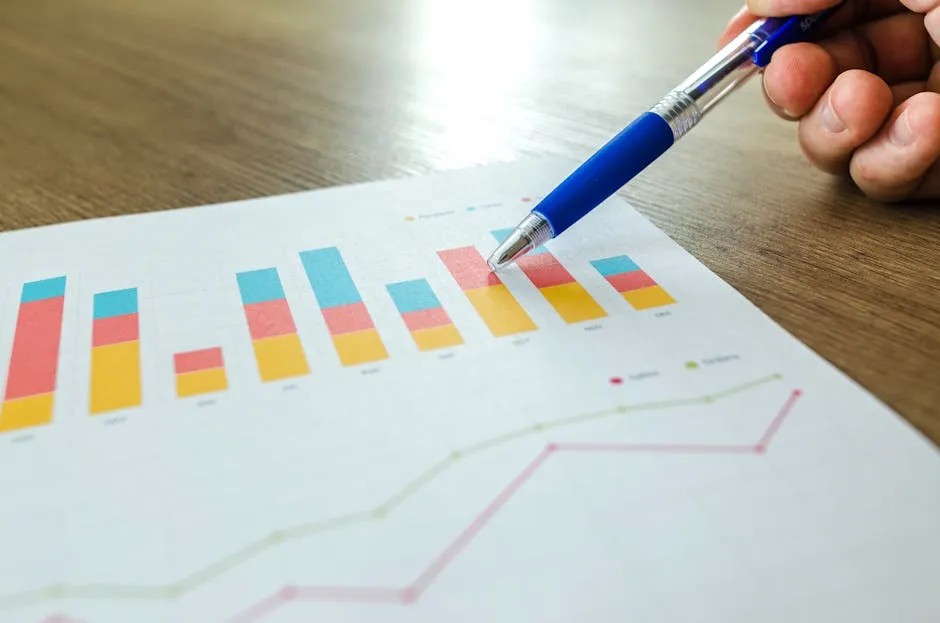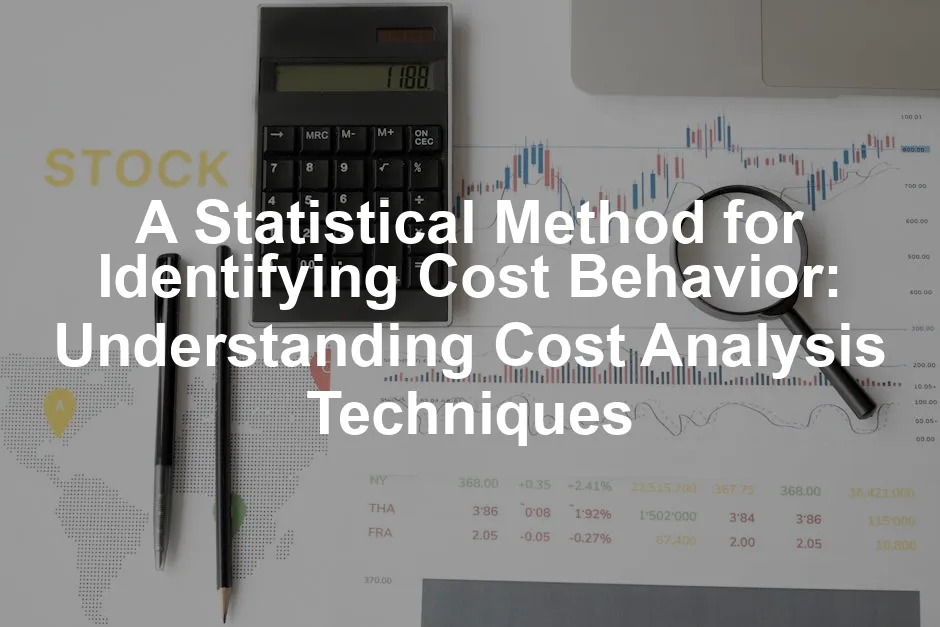Introduction
Understanding cost behavior is crucial for effective managerial accounting. Think of cost behavior as the financial pulse of a business. It reveals how costs react to changes in activity levels. Are they fixed, variable, or mixed? Knowing this helps managers make smart decisions and forecast future costs accurately.
When businesses grasp cost behavior, they can predict how changes in production levels will affect overall expenses. This insight is invaluable for budgeting, pricing, and strategic planning. Imagine a company ramping up production for a holiday season. Understanding cost behavior can help avoid surprises when the bills come in.
This article aims to explore various statistical methods for identifying cost behavior. We particularly focus on the least-squares regression method—an analytical gem that uses all available data to yield precise insights. The least-squares method is like a wise sage, gathering all information before making decisions.

If you’re keen on mastering Excel for your business needs, consider grabbing a copy of Excel 2021 for Dummies. It’s a fantastic resource for anyone wanting to get their spreadsheets in order!
We’ll cover several statistical techniques, including scatter diagrams, the high-low method, and the least-squares regression method. Each section will delve into these methods, showcasing applications and real-world examples. By the end of this article, readers should feel empowered to apply these techniques in their financial analyses.
Understanding Cost Behavior
Definition of Cost Behavior
Cost behavior refers to how costs change in response to varying levels of activity. It’s essential for businesses to classify costs effectively. Generally, costs fall into three categories: fixed, variable, and mixed.
Fixed costs remain constant regardless of production levels. Think of rent or salaries; they don’t fluctuate with production. Variable costs, on the other hand, change with output. More production means more raw materials are needed. Lastly, mixed costs have both fixed and variable components. For example, a utility bill may have a base charge (fixed) plus additional charges based on usage (variable).
Understanding these classifications is vital for financial management. Accurate cost behavior analysis helps businesses forecast expenses, set prices, and make informed operational decisions. When managers grasp how costs respond to changes in activity, they can navigate their companies through financial waters more smoothly.
A comprehensive understanding of cost behavior also aids in developing effective budgets. Without knowing how costs behave, businesses might overestimate or underestimate their needs, leading to cash flow issues. Thus, mastering cost behavior is not just a technical skill; it’s a strategic advantage in any competitive landscape.

Relevance in Business Decision-Making
Understanding cost behavior is like having a crystal ball for financial forecasting. It gives businesses a sneak peek into how costs will shift as activity levels change. This knowledge is critical in budgeting, forecasting, and strategic planning.
Let’s break down how this works. When a business prepares its budget, it needs to know which costs are fixed and which are variable. Fixed costs, like rent and salaries, stay the same regardless of production levels. Variable costs, like raw materials, fluctuate with activity. Knowing this helps avoid budget overruns and ensures adequate cash flow.
Consider a bakery gearing up for the holiday rush. If they understand that their ingredient costs rise with increased production, they can budget accordingly. They can also plan for hiring extra staff, knowing that labor costs will rise during peak times. This proactive planning prevents last-minute scrambles that can lead to overspending.
Forecasting is another area where cost behavior shines. Businesses often look at historical data to predict future costs. If a company sees that its shipping costs rise with sales volume, it can forecast future expenses more accurately. This is especially useful for seasonal businesses that experience fluctuating demand. For more on this, check out our article on forecasting trends in manufacturing with time series analysis.

If you’re interested in diving deeper into financial management, Financial Management: Theory and Practice is a must-read. It’s packed with essential insights to help you navigate the financial landscape.
Understanding how to forecast expenses can significantly enhance your budgeting accuracy. Explore more about this topic here.
In strategic planning, understanding cost behavior is paramount. For instance, a manufacturer contemplating a new product line needs to analyze how additional costs will impact profitability. If fixed costs remain high while variable costs are low, it might be a good idea to proceed. Conversely, if both types of costs are expected to rise significantly, it could spell trouble.
Real-world examples abound. Take a tech startup launching a new app. They might find that their server costs are fixed, but customer support costs are variable. This knowledge helps them gauge how scaling up will impact their budget.
In summary, grasping cost behavior equips businesses with the tools to make informed decisions. It aids in crafting realistic budgets, accurate forecasts, and sound strategic plans. Companies that master this aspect of financial management are better positioned to thrive in competitive environments. So, the next time you look at your budget, remember—understanding costs isn’t just smart; it’s essential!

Least-Squares Regression Method
Explanation of the Method
The least-squares regression method is a statistical technique that estimates cost behavior by using all available data points. Unlike other methods, which may only use a couple of points, this method analyzes the entire dataset. It creates a cost behavior equation that reflects how costs change with different levels of activity.
Imagine you’re trying to predict how much you’ll spend on groceries. If you only look at your highest and lowest grocery bills, you might miss the bigger picture. Least-squares regression takes into account every grocery bill you’ve ever had, helping you see trends and patterns. It’s like having a superpower for budget planning!
The method calculates a line of best fit through the data points. This line minimizes the distance between the actual data points and the line itself. The resulting equation typically takes the form:
Y = a + bX
Here, Y represents total costs, a is the fixed cost, b is the variable cost per unit, and X is the activity level.

Advantages and Limitations
The primary advantage of the least-squares regression method is its accuracy. By utilizing all available data points, it provides a more precise estimation of cost behavior than simpler methods like the high-low method. This accuracy can lead to better financial forecasts and budgeting strategies.
However, it’s not all sunshine and rainbows. The method can be complex and may require statistical knowledge to perform correctly. It also assumes a linear relationship between costs and activity levels. If costs behave non-linearly, the results may be less reliable.
Let’s look at a quick example to illustrate how to calculate regression coefficients. Suppose we have the following data points representing production levels and associated costs:
| Production Level (X) | Total Cost (Y) |
|---|---|
| 1 | 200 |
| 2 | 300 |
| 3 | 400 |
| 4 | 500 |
To find the coefficients, you would calculate the slope (b) and intercept (a). For our example, the slope would show how much costs increase with each additional unit produced, while the intercept represents costs when production is zero. This mathematical insight is what makes least-squares regression so powerful in understanding cost behavior.
In summary, the least-squares regression method is your best friend in the world of cost estimation. It’s accurate, comprehensive, and provides valuable insights. Just be prepared for a bit of math along the way!

Practical Applications of Cost Behavior Analysis
Case Studies and Examples
Businesses that understand cost behavior often thrive. Let’s look at some real-world examples that illustrate this point.
Consider a popular coffee chain. They implemented the least-squares regression method to analyze their variable costs, such as coffee beans and milk. By examining historical sales data, they discovered that their costs per unit decreased as sales volume increased. This insight allowed them to optimize pricing strategies and negotiate better deals with suppliers. As a result, they improved profit margins by 15% over just one fiscal year. Not a bad perk, right?
Next, let’s examine a local bakery gearing up for the holiday season. They used the high-low method to estimate their costs. By assessing the highest and lowest production levels, they predicted ingredient costs accurately. This foresight enabled them to budget for additional staff, ensuring they didn’t face unexpected labor costs during peak times. The bakery thrived, achieving a 30% increase in holiday sales compared to the previous year. Talk about a festive success!
Another example comes from a tech startup that utilized scatter diagrams to visualize their costs. They plotted data points of monthly expenses against user growth. A clear trend emerged: as user numbers increased, their customer support costs rose significantly. This prompted the startup to invest in a more efficient support system. Ultimately, they optimized operations and reduced costs by 25% while increasing customer satisfaction. Who doesn’t love a happy customer?
These examples highlight how statistical methods can drive significant business outcomes. Understanding cost behavior enables companies to make informed financial decisions, resulting in improved efficiency and profitability.

Tools and Software
Cost behavior analysis doesn’t have to be complicated. Several tools streamline this process, making it accessible to businesses of all sizes.
First up, Excel. This ubiquitous software is a powerhouse for financial analysis. With built-in functions, users can easily perform regression analysis, create scatter diagrams, and visualize data trends. The ability to manipulate data tables and employ various statistical tools makes Excel a go-to option for many finance professionals. For a comprehensive guide on descriptive statistics in Excel, check out this resource.

If you want to enhance your skills further, consider checking out Business Statistics for Dummies. It’s an excellent resource for understanding the stats that drive business decisions.
Excel is an essential tool for financial analysis, helping users perform various statistical techniques efficiently. Learn more about it here.
Next, specialized accounting software like QuickBooks Desktop Pro 2021 or Sage can simplify cost behavior analysis. These platforms often come equipped with reporting features that automatically categorize costs as fixed or variable. This saves time and reduces the chances of errors when analyzing data. Automated reports provide valuable insights, empowering businesses to make data-driven decisions without getting lost in spreadsheets.
Lastly, there are dedicated statistical software tools such as SPSS Statistics Standard GradPack or R. These programs are designed for those looking to delve deeper into data analysis. They offer advanced statistical techniques, including complex regression models and data visualization options. While they may require a learning curve, the insights gained can be invaluable for businesses aiming to refine their cost structures. For more information on R, visit our article on the AP statistics formula sheet.
Using R for statistical analysis can greatly enhance your understanding of cost behavior. Discover more about R here.
In summary, whether you’re a small bakery or a tech startup, leveraging the right tools can significantly enhance your cost behavior analysis. The combination of user-friendly software and statistical methods empowers businesses to make informed financial decisions and stay ahead of the competition.

Conclusion
Understanding cost behavior is crucial for effective financial management. By employing statistical methods like least-squares regression, businesses can analyze their costs with precision. This insight leads to better budgeting, forecasting, and strategic planning.
Through real-world examples, it’s clear that companies that harness these methods experience tangible benefits. From increased profits to improved operational efficiency, the outcomes speak volumes. Moreover, utilizing accessible tools like Excel and specialized accounting software can streamline the analysis process, making it easier for businesses to implement these insights.
If you’re interested in starting your own business, check out The Everything Guide to Starting and Running a Restaurant. It’s a great resource for aspiring restaurateurs!
In essence, mastering cost behavior analysis is not just a mathematical exercise; it’s a strategic advantage. Businesses that invest time and resources in understanding their cost structures are better equipped to navigate the challenges of today’s competitive landscape. So, whether you’re a startup or an established firm, consider adopting these methods to enhance your financial decision-making and pave your way to success.

Final Thoughts
Understanding cost behavior is more than just crunching numbers; it’s about making informed decisions. Businesses that adopt statistical methods, like least-squares regression, can significantly improve their financial management. These methods provide clarity in cost predictions and budgeting, which are essential for staying competitive.
Imagine a restaurant discovering that its ingredient costs fluctuate with customer traffic. By utilizing cost behavior analysis, it can anticipate busy nights and adjust inventory accordingly. This kind of proactive approach helps prevent waste and optimize profits.
If you want to sharpen your business acumen, The Personal MBA: Master the Art of Business is a fantastic read that condenses essential business knowledge.
As we look to the future, there are many areas ripe for exploration. For instance, how can artificial intelligence enhance cost behavior analysis? Could machine learning algorithms predict costs with even greater accuracy? These questions open a door to exciting research opportunities.
Furthermore, businesses should consider integrating cost behavior analysis into their regular reviews. Regular assessments can highlight trends, identify potential issues early, and lead to better strategic planning.
Ultimately, the journey of understanding cost behavior is ongoing. It requires commitment, curiosity, and a willingness to adapt. By embracing these statistical methods, businesses can navigate the financial landscape with confidence and agility.

FAQs
What is the most accurate method for identifying cost behavior?
The least-squares regression method stands out as the most thorough. It uses all available data points, making it a comprehensive approach to estimating cost behavior.
How do fixed costs differ from variable costs?
Fixed costs remain unchanged regardless of production levels. Think rent or salaries. Variable costs, however, fluctuate with output. For example, raw materials increase as production ramps up.
Can cost behavior analysis predict future costs?
Yes, it can! However, there are limitations. Cost behavior analysis uses historical data to make predictions. Unexpected changes in the market or operations can still lead to inaccuracies.
What are the common pitfalls in cost behavior analysis?
Common mistakes include oversimplifying cost categories or disregarding relevant data. Ignoring trends or using outdated data can also skew results, leading to poor decision-making.
How often should businesses analyze their cost behavior?
The frequency depends on business needs and industry standards. A good rule of thumb is to review cost behavior quarterly or during significant operational changes. Regular analysis keeps financial strategies relevant and effective.
Please let us know what you think about our content by leaving a comment down below!
Thank you for reading till here 🙂
All images from Pexels




